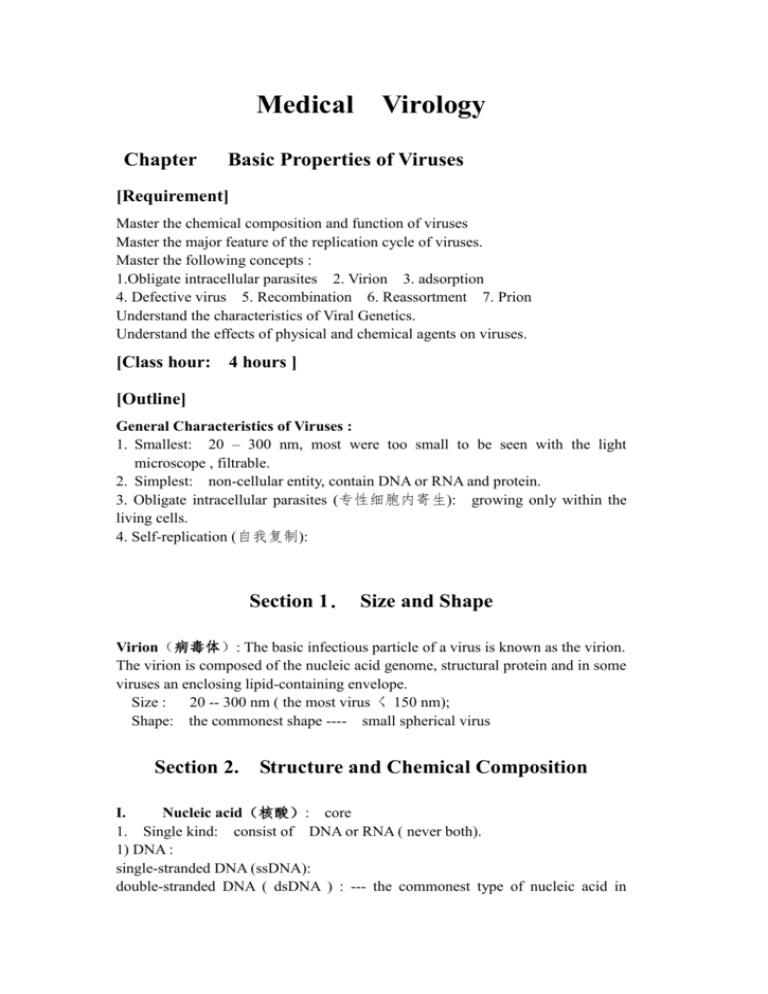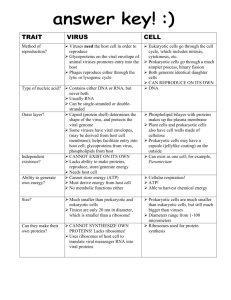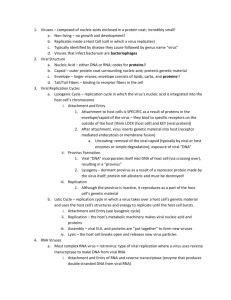of Viral Infection
advertisement

Medical Chapter Virology Basic Properties of Viruses [Requirement] Master the chemical composition and function of viruses Master the major feature of the replication cycle of viruses. Master the following concepts : 1.Obligate intracellular parasites 2. Virion 3. adsorption 4. Defective virus 5. Recombination 6. Reassortment 7. Prion Understand the characteristics of Viral Genetics. Understand the effects of physical and chemical agents on viruses. [Class hour: 4 hours ] [Outline] General Characteristics of Viruses : 1. Smallest: 20 – 300 nm, most were too small to be seen with the light microscope , filtrable. 2. Simplest: non-cellular entity, contain DNA or RNA and protein. 3. Obligate intracellular parasites (专性细胞内寄生): growing only within the living cells. 4. Self-replication (自我复制): Section 1. Size and Shape Virion(病毒体): The basic infectious particle of a virus is known as the virion. The virion is composed of the nucleic acid genome, structural protein and in some viruses an enclosing lipid-containing envelope. Size : 20 -- 300 nm ( the most virus く 150 nm); Shape: the commonest shape ---- small spherical virus Section 2. Structure and Chemical Composition I. Nucleic acid(核酸): core 1. Single kind: consist of DNA or RNA ( never both). 1) DNA : single-stranded DNA (ssDNA): double-stranded DNA ( dsDNA ) : --- the commonest type of nucleic acid in viruses of human. 2) RNA: double-stranded RNA (dsRNA) : single-stranded RNA (ssRNA): --- the commonest type of nucleic acid in viruses of human.. +ssRNA : is the same as the viral mRNA ,can direct as viral mRNA -ssRNA: as a template transcribe complementary mRNA. 2. Function: 1) genome (基因组): encodes genetic information. 2) infectious nucleic acid(感染性核酸): refer to some viral nucleic acid which can enter cells and reproduce new viruses. *segment of RNA (分节段 RNA) *open reading frame, ORF(开放读码框) II. Capsid (衣壳): protein coat , 1. capsid is composed of distinct morphologic units---- capsomeres(壳粒) --- icosahedral symmetry --- helical symmetry --- complex symmetry 2. Function: 1) protection (protect viral nucleic acid from enzymic action). 2) specific binding sites. 3) antigenicity of capsid protein. III. Envelope (包膜): 1. Consists of lipid bilayer and glycoprotein: lipid --- derived from host cell membrane. Glycoprotein--- coded by the viral genome. Spikes(刺突) --- virus-encoded glycoprotein spikes which are important for adsorption and entry into the host cell. 2. Function: 1) as the binding sites(for enveloped virus). 2) antigenicity of glycoprotein. IV . Non-structural protein: (1) viral enzymes: such as : RNA-dependent RNA polymerase or transcriptase . (2) specific viral protein: such as : transformation protein of tumor virus. Section 3 . Viral Multiplication I. Replication cycle(复制周期): 1. adsorption (吸附): interaction between specific binding sites on viral capsid (or envelope) and specific receptors on host cell surface. 2. penetration(穿入): 3. uncoating(脱壳): 4. biosynthesis(生物合成): 1) early transcription and translation: early proteins ( non-structural proteins): --- enzyme which is necessary for viral replication. --- specific viral proteins: regulation protein (调节蛋白). 2) replication of viral nucleic acid (DNA or RNA): 3) late transcription and translation : structural proteins. 5. assembly and release(装配和释放): --- by lysis of the host cell ( naked viruses). --- by budding through cell membrane (enveloped viruses). II. Unnormal multiplication: 1. Defective virus(缺陷病毒): a defective virus is one that lacks one or more functional genes required for virus replication. defective virus require helper activity from another virus for some step in replication. 2. Abortive infection: non-permissive cell 3. Interference(干扰现象):The infection of cell by a virus results in that cell becoming resistant to infection by other viruses. Section 4. Viral Genetics 1. Mutations: permanent changes in sequence of nucleotides in nucleic acid. Mutant(突变株)--temperature sensitive mutant, ts 突变株 --- host-range mutant, hr 突变株 --- drug-resistant mutant,耐药突变株 2. Recombination (重组)and reassortment(重配): exchange of genetic material between two viruses which infected the same cell. between two segmented viruses ---- reassortment(重配) 3. Complementation(互补作用): genetic production reactivation between two viruses. 4. Integration(整合): viral genome insert into host cell DNA . Section 5. Effects of Physical and Chemical Agents on Viruses Section 6. Classification of Animal Viruses Section 7. Subvirus Subvirus : refer to the kind of infectious factor which is smaller than virus. 1. viroid(类病毒) and virusoid(拟病毒): only +ssRNA, cause plant disease. 2. prion (朊病毒,朊粒, ): 1) only protein(prion protine, PrP) cause animal and human central nervous system disease. cellular PrP, PrPc (细胞朊蛋白) ---- normal scrapie prion protine, PrPsc (羊瘙痒病朊蛋白) ---- pathogenic 2) animal prion disease: scrapieof sheep and goat (羊瘙痒病), bovine spongiform encephalopathy, BSE( 牛海绵状脑病, 疯牛病) human prion disease: Kuru disease (库鲁病), CJD(克-雅病), variant CJD, v- CJD(克-雅病变种) Chapter Viral Infection and Pathogenicity [Requirement] Master the the pathways of viral infections and the viruses which can result in vertical infection . Master the pathogenesis of viral infection and the oncogenic virus associated with human tumors. Master the the characteristics of immunity against virus infection Master the the antiviral activity of IFN. Master the following concepts : 1.vertical transmission 2 . latent infection 3. slow virus infection 4.Interferon (IFN) 5. AVP 6. neutrilizing antibody 7. CPE Understand the classification of IFN and the production of IFN. [Class hour: 4 hours ] [Outline] Section 1 . The pathways of viral infections I. II . horizontal transmission: (水平传播): vertical transmission(垂直传播): from mother to infants or child: --- through placenta ( congenital infection, congenital deformity 先天性畸形) --- through birth canal (infection of newborn 新生儿感染) The viruses which can result in congenital infection : 1)rubella virus 风疹病毒 2)cytomegalovirus(CMV) 巨细胞病毒 3)herpes simplex virus(HSV)单纯疱疹病毒 4)hepatitis B virus(HBV)乙肝病毒 5)human immunodeficiency virus (HIV)人类免疫缺陷病毒 Section 2. The type of viral infection I. acute viral infection: II. persistent viral infection: 1. chronic infection: virus can be continuously detected. 2. latent infection 潜伏感染: virus is usually not detectable but patient may have periodic out-breaks of disease. 3. slow virus infection 慢病毒感染: with long incubation periods(years), subacute progressive, cause by lentivirus(HIV) or unconventional virus ( prion)。 Section 3 . Pathogenesis of Viral Infection I. virus – cell interactions: 1. cytocidal effect 杀细胞感染 virus which infect and replicate within cells causing the cells to lyse when the progeny virions are releaed. cytopathic effec, CPE 2. steady state infection 稳定状态感染: viruses are produced from the infected cells but the cells are not killed by the process. --- integration of viral Ag in cell membranes. --- cell fusion. 3. integration 整合作用: integration of the viral genome into cellular DNA . oncogenic virus --- induces cell transformation The oncogenic virus associated with human tumors: HBV--- hepatocellular carcinoma HPV --- cervical carcinoma EBV --- Burkitt lymphoma , nasopharyngeal carcinoma HSV-2 --- cervical carcinoma HTLV --- T cell leukemia II. virus – immune system interaction: 1. immunopathological reactions: 2. the injury of immune system induced by virus infection: Section 4. Immunity against virus infection I. Non-specific immunity: 1. Interferon (IFN): a class of protein(glycoprotein) produced by cells in response to viral infection or other interferon inducers that protected other cells of same species from attack by a wide range of viruses. 2. classification of IFN: IFN-α IFN-β IFN-γ Gene chromosome 9 chromosome 9 chromosome 12 cell blood mononuclear cell fibroblasts Ag-activated T cell anti-viral activity +++ +++ ++ modify immune responses ++ ++ +++ 3. production of IFN: interferon inducers: eg. PolyI:C, viruses and bacterial endotoxins, etc Mechanism : IFN inducer acts on cell receptors --- IFN gene activation --- transcribe IFN mRNA--- IFN synthesis--- IFN released 4. antiviral activity: not act directly on virus, but through induction of antiviral proteins(AVP). Mechanisms: IFN combines with specific receptor on cell surface ---AVP gene actived --- AVP mRNA transcribed---AVP synthesis AVP consists of : protein kinase 2,5-A synthetase 2,5-A phosphorylated eIF2 activated Rnase L dissociate viral mRNA inhibit viral protein synthesis Characteristics : (1) not act directly on virus . (2) broad-spectrum antiviral activity. (3) host species specific: inhibit viral replication only in the species in which it was produced. 5. other activities: NK activation macrophage activation Increased expression of MHC molecules II. Specific immunity 1. Humoral immunity Neutrilizing antibody: the blocking of virus replication by inhibition of adsorption, penetration or uncoating. virolysis --- with the aid of complement --- by phagocytosis act on free viruses , but can’t influence intracellular virus directly. 2. Cell mediated immunity: the destruction of an infected cell before progeny particles are released --- an effective way of terminating a viral infection. CTL: react with membrane-bound viral antigens and lyse the infected cells. release some lymphokines(IFN-r, TNF- ). Th : release lymphokines. K cell: ADCC. NK cell: lyse infected cell directly. Chapter The Examination and Treatment of Viral Infection [Requirement] [Class hour: 1 hours ] [Outline] Understand the examination methods of viral infection. Understand the characteristics of viral vaccines and antiviral agents. Section 1. The Examination of Viral Infection I. Detection of living virus: 1. animal injection(动物接种): 2. chicken embryo culture(鸡胚培养): 3. cell culture(细胞培养): primary(原代)cell culture: continuous (传代) cell culture: growth phenomenon of virus: (1) cytopathic effect (CPE)(细胞病变): (2) inclusion body(包涵体): (3) hemadsorption(血细胞吸附): (4) plaque forming units (PFU)(空斑形成单位): II. Detection of viral antigen and antibody: ELISA, immuno-fluorescence , Western-blot III. Detection of viral nucleic acid: PCR, RT-PCR, Biochip (生物芯片) Section 2 Prevention and Treatment of viral infection I. Treatment of viral infection: 1. antiviral agents: 1) IFN: 2) chemical agents: ACV(acyclovir)无环鸟苷――treatment of HSV through the inhibition of the viral DNA polimerase. AZT-- -- inhibit reverse transcriptase in the retroviruses. 3) gene therapy: antisense oligonuclotide,asON 反义核酸 ribozyme 核酶 II. Immunization Prevention of viral infection: 1. Vaccines: inactivated vaccines: attenuated-live vaccines: *gene engineering vaccines: *DNA vaccines: *recombined viral vector vaccines: 2. Artificial passive immunization:





